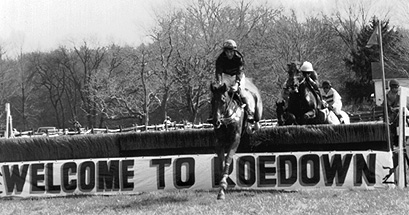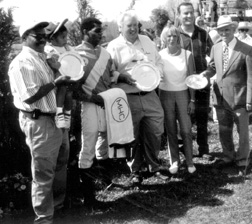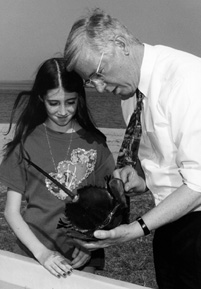
Dock of the Bay

Volume VI Number 13
April 2-8, 1998
At Roedown Races, All Who Showed Won
photos by Bill Lambrecht
It was the kind of day dreams come true.
For the second year running, spring smiled on the Marborough Hunt Races at Roedown Farm, and if anybody had a bad word to say about the weather, it could have amounted to only three letters: hot!
A fair day on the last Sunday in March, in the year of El Niño's rampage no less, seemed nearly 5,000 racegoers' dream come true. Body parts long hidden even in this mild, wet winter exposed themselves as unhesitatingly as new leaves. Spread out over the rolling Southern Maryland hills of 218-acre Roedown Farm - country that lets you forget that sprawl has come creeping - youth and age basked in the sun. But sunshine was hardly the only dream come true at the 24th running of the Roedown races.
Owners and stables, riders and bettors had some dreams come true in the nine races spread over four hours. Every race had its heroes and hard-luck stories, its favorites and its follies, but you couldn't have found a better fable of courage kindled by competition - which may be what racing is all about - than the hard-run fourth, the Benjamin H.C. Bowie Memorial.
That three-mile test of endurance was so daunting that eight horses dropped from the field of 10. That defection brought only two horses - No. 3, the six-year-old chestnut gelding Newport, and No. 4, the six-year-old dark brown gelding Holzmann - to the starting line.
Curiously, both were trained by Jack Fisher, who was up on Newport - owned by his mother, Mrs. John R.S. Fisher - wearing green and pink diagonal quarters, green sleeves and pink cap. Andrew Wilson, on Holzmann, wore the green, blue and white of Kingfisher Farm.
Round and round the timber course and its six hurdles the sweat-streaked horses raced, Newport, wearing pink sox, and Holzmann, wearing green. For much of the race they were biding their time, husbanding their wind, their jockeys high in the stirrups. One would gain a couple of lengths, only to hear the heavy breath of his gaining stout-hearted competitor. Around one turn, Holzmann would take the lead. Far in the backstretch, Newport came forward.
Little wild cheering accompanied their run. Instead, on-lookers felt for and with the horses, wondering, guessing, when one or the other would lose his breath and fold. "Green's had it," a spectator would say, or "Pink's all in." And still the see-sawing continued, so that just when you knew one or the other of those champions couldn't, wouldn't, take another jump, the horse surged.
When they finally reached the finish line, it was Holzmann, by 10 lengths in six minutes, 56 and three-fifths second, who stood in the winner's circle and won the lion's share - $700 - of the $1,000 purse contributed by Chaney Enterprises. But nobody there called Newport a loser.
 Dreams came true, too, for a few chefs
and many more eaters for whom the afternoon had as much to do with picnicking
as with racing. At 150 parties, tailgates were spread with delicacies ranging
from asparagus to roe, from red beef to smoked salmon, from chocolate strawberries
to champagne. Hundreds of guests feasted, and a handful of hosts heard their
affairs proclaimed the finest in the land.
Dreams came true, too, for a few chefs
and many more eaters for whom the afternoon had as much to do with picnicking
as with racing. At 150 parties, tailgates were spread with delicacies ranging
from asparagus to roe, from red beef to smoked salmon, from chocolate strawberries
to champagne. Hundreds of guests feasted, and a handful of hosts heard their
affairs proclaimed the finest in the land.
Jim Price, Anita Morris and Kurt Maisel won top honors for the second year in a row, followed by the Beeman-Auth Brothers Luau in second place and Jessica and Tom McCarthy in third. Most unique was another perennial prize winner, Loedown, sponsored by Adams the Place for Ribs, ReMax Innovations and Greg Taylor Construction, Heritage Farm and Henry Murray Insurance.
But just as every race has its favorite, every story has its hero.
We found ours in Troy Lively, who rode the five-year-old chestnut gelding Old Firehouse to victory and the $700 winner's share of a $1,000 purse - contributed th Prince George's Equstrian Center - in the third race, the John. D. Bowling Memorial.
Lively, of Phoenix, Md., stayed in the pack with his eyes searching for hard ground on the mushy course. He found enough of it to edge Aggro Crag, Darn Tipalarm and Approaching Squall.
At 23, Lively is doing just what he wants to in life and doing it well, it seems. Next, again riding for Larry Smith, who trains Old Firehouse, he'll compete in the Middleburg Spring Races.
Lively described the thrill of galloping in the pack, surrounded by other riders and their animals, all the while planning his attack. Whether it matched the thrill of traversing elegant buffets on a magical spring day, we can't say. But Lively - who's making a career of the only work in the world he loves - doesn't mind staying lean.
"It's just you and your horse out on that course; you're the team," said Lively, one of many winners at Roedown Farm.
-SOM
Horseshoes Find Friends in High Places
photo by Steve Armstrong
It was almost as tough for Gov. Parris Glendening to get to the beach
to issue to protect horseshoe crabs as it is for horseshoe crabs to get
to the beach to lay their eggs.
After wading through miles of dense Bay Bridge traffic, the governor arrived on Kent Island where he met a group of scientists, environmentalist and constituents. There he issued an executive order that will protect the species, declaring that "although horseshoe crabs are neither valued for their beauty nor their delectable taste in seafood dishes, they serve an integral role in the marine ecosystem."
For their part, horseshoe crabs, one of the Bay's oldest occupants, find their traditional nesting grounds blocked by seashore development and erosion.
Horseshoes' problems don't end there. Over the last decade, commercial interest in the bottom-dwelling, worm-eating anthropod has boomed. Because the 360-million-year-old species is the best bait for eel, conch and catfish - some of the culinary world's trendiest dishes - its population has been cut almost in half over the last decade.
And because every food chain is complex, what's happening to horseshoe crabs affects other species. The National Audubon Society, for instance, has noted that the number of migratory birds who stop in the mid-Atlantic has declined. The birds, en route from South America to Canada, stop in our waters to rest and to refresh themselves on the eggs of horseshoe crabs - eggs that are deposited every May and June in the region's beaches.
And with fewer crabs, fewer eggs - and with fewer eggs, fewer birds, and since the watching of birds, or birding, is a big chunk in the region's $500 million wildlife-watching industry, protecting horseshoe crabs has become more than an environmental issue.
Glendening believes that the new regulations will cut the yearly harvest by 72 percent. He's ordered caps on daily catches, a season and a mile-wide "no horseshoe crabbing" zone along the state's beaches during spawning. These regulations exceed those set by our northern neighbors, Delaware and New Jersey.
"Let's hope," said the governor, on a beach where the helmet-shaped creatures like to spawn, "these efforts will ensure that this extraordinary creature will continue to fascinate and benefit future generations."
-Steve Armstrong
After State Axing, Venerable Cruising Guide Is Back
The boating season can begin after all.
After losing the state of Maryland as a partner last fall, the '98-'99 Maryland Cruising Guide is back - and on the streets. It has a new name, it's slightly more compact and it looks better than ever.
 "It's gone smooth as silk,"
said Dick Heintz, the long-time printer of the tricky job, who continued
on the team up with 16-year editor Mickey Courtney to put out the Guide.
"We even beat our deadline by five days."
"It's gone smooth as silk,"
said Dick Heintz, the long-time printer of the tricky job, who continued
on the team up with 16-year editor Mickey Courtney to put out the Guide.
"We even beat our deadline by five days."
Yet there was a time when its fate was in doubt.
Since 1961, the Department of Natural Resources published the Guide for Cruising Maryland Waters. Next to the motor, it was viewed by many Chesapeake captains as the most important item on their boats.
For the Guide leads boaters like a seeing-eye dog, charting depths, enumerating dangers and marking channels. In its water-resistant pages, charts scaled 1:80,000 detail the world's largest estuary as neatly as if every inch of it were Courtney's home town.
The Maryland guide is believed to be the first of its sort in the country, and in nearly 40 years it has been copied many times.
But even the Bible has lost publishers over the years. And that's what happened to the Guide last year when DNR started looking for places to cut.
"It's been a wonderful publication. But when departments were told they had to reduce their spending, top management thought we ought to let that be pursued in the private sector," Sarah Taylor Rogers, a DNR assistant secretary, said at the time.
Privatization is a rallying cry, if not a buzzword, in this new post-balanced budget era. It doesn't always work. But with the Maryland Cruising Guide, so far it has, judging by its availability since mid-March for $20 at virtually every marine supply store in Maryland as well as by mail.
It's updated, stripped of verbiage to please the state and beefed-up in critical sections like how to get help on the water.
"It's a lot easier without the state," said Heintz, of Williams & Heintz Map Corp. in Capitol Heights.
If you'd rather shop by phone, call your order into Heintz at 301/336-1144.
-NBT
In Washington, a bill to phase out floating fishing factories over 165-feet long is winning diverse support ranging from Alaska Sen. Ted Stevens (R), its sponsor, to Greenpeace. But the Clinton Administration has not signed on. The ban could keep foreign-owned trawlers outside of U.S. waters - including the Atlantic Ocean at the mouth of the Chesapeake Bay ...
In Vermont, Lake Champlain's brief brush with greatness is over. We told you last week how Lake Champlain was on its way to gaining the status of the sixth Great Lake. But with huffy Michigan legislators in the lead, Congress has voted to strip the designation before it becomes official ...
Florida Gov. Lawton Chiles (D) is in hot water with environmental advocates for approving a plan to build a commercial airport between the Biscayne and Everglades national parks on the old Homestead Air Base ...
Also in Florida, the Nature Conservancy succeeded last week in acquiring 900 acres of waterfront property on the Tarkiln Bayou Peninsula that had been scheduled for development. The price was not cheap: $13.5 million ...
Our Creature Feature this week comes to us from the North Dakota Badlands, where bighorn sheep and oil wells aren't living in harmony. According to a University of North Dakota study, the maintenance of the oil wells is disrupting herds, sapping the bighorns' energy and making them restless.
Now is an especially difficult time for the bighorns. Why? Because its lambing season.
| Back to Archives |
Volume VI Number 13
April 2-8, 1998
New Bay Times
| Homepage |